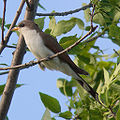Coccyzus
| Coccyzus | |
|---|---|

| |
| Black-billed cuckoo (Coccyzus erythropthalmus) | |
| Scientific classification | |
| Domain: | Eukaryota |
| Kingdom: | Animalia |
| Phylum: | Chordata |
| Class: | Aves |
| Order: | Cuculiformes |
| Family: | Cuculidae |
| Genus: | Coccyzus Vieillot, 1816 |
| Type species | |
| Cuculus americanus (yellow-billed cuckoo) Linnaeus, 1758
| |
| Species | |
|
13, see text | |
| Synonyms | |
|
Hyetornis | |
Coccyzus is a genus of cuckoos which occur in the Americas. The genus name is from Ancient Greek kokkuzo, which means to call like a common cuckoo. The genus includes the lizard cuckoos that were formerly included in the genus Saurothera.
Taxonomy
[edit]The genus Coccyzus was introduced in 1816 by the French ornithologist Louis Pierre Vieillot to accommodate a single species, Comte de Buffon's "Coucou de la Caroline", now the yellow-billed cuckoo. This which is therefore the type species.[1][2] The genus name is from the Ancient Greek kokkuzō meaning "to cry cuckoo".[3]
The results of a molecular phylogenetic study of the cuckoo family by Michael Sorenson and Robert Payne that was published in 2005 lead to a reorganization of some of the genera. Based on this study, the genera Saurothera (the lizard cuckoos) and Hyetornis (chestnut-bellied and bay-breasted cuckoos) were lumped with Coccyzus while the ash-colored cuckoo and dwarf cuckoo, at one time separated in Micrococcyx, were found to be closest relatives of the little cuckoo, formerly in Piaya. These three species were placed in the resurrected genus Coccycua.[4][5]
Species
[edit]The genus contains 13 species:[6]
| Image | Common Name | Scientific name | Distribution |
|---|---|---|---|
 |
Black-billed cuckoo | Coccyzus erythropthalmus | Eastern North America, the Caribbean, Central America, and the Andes |
 |
Yellow-billed cuckoo | Coccyzus americanus | Eastern United States, Central America, and eastern South America |
 |
Pearly-breasted cuckoo | Coccyzus euleri | Argentina, Bolivia, Brazil, Colombia, Ecuador, French Guiana, Guyana, Paraguay, Suriname, Peru, and Venezuela |
 |
Mangrove cuckoo | Coccyzus minor | southern Florida in the United States, the Bahamas, the Caribbean, both coasts of Mexico and Central America, and the Atlantic coast of South America as far south as the mouth of the Amazon River. |
| Cocos cuckoo | Coccyzus ferrugineus | Costa Rica | |
 |
Dark-billed cuckoo | Coccyzus melacoryphus | Argentina, Bolivia, Brazil, Colombia, Ecuador, French Guiana, Guyana, Paraguay, Peru, Suriname, Trinidad and Tobago, Uruguay and Venezuela |
| Grey-capped cuckoo | Coccyzus lansbergi | Aruba, Colombia, Ecuador, Netherlands Antilles, Panama, Peru, and Venezuela. | |
 |
Chestnut-bellied cuckoo | Coccyzus pluvialis | Jamaica |
 |
Bay-breasted cuckoo | Coccyzus rufigularis | Dominican Republic |
 |
Great lizard cuckoo | Coccyzus merlini | The Bahamas (on Andros, Eleuthera and New Providence) and Cuba |
 |
Puerto Rican lizard cuckoo | Coccyzus vieilloti | Puerto Rico |
 |
Jamaican lizard cuckoo | Coccyzus vetula | Jamaica |
 |
Hispaniolan lizard cuckoo | Coccyzus longirostris | Hispaniola (both Haiti and the Dominican Republic) |
Description and ecology
[edit]These birds are of variable size with slender bodies, long tails and strong legs. Many have black and white undertail patterns. They occur in a variety of forests, woodlands or mangroves.
Coccyzus cuckoos, unlike many Old World species, build their own nests in trees and lay two or more eggs. Yellow-billed and black-billed cuckoos occasionally lay eggs in the nests of other birds, but are not obligate brood parasites like the common cuckoo of Eurasia.
Northern species such as yellow-billed and black-billed cuckoos are strong migrants, wintering in Central or South America, and occasionally wander to western Europe as rare vagrants, but the tropical Coccyzus cuckoos are mainly sedentary.
These are vocal species when breeding, with persistent and loud calls. They feed on large insects such as cicadas, wasps and caterpillars (including those with stinging hairs or spines which are distasteful to many birds). Lizard cuckoos are large and powerful species, and mainly take vertebrate prey, especially, as the name implies, lizards.
References
[edit]- ^ Vieillot, Louis Pierre (1816). Analyse d'une Nouvelle Ornithologie Élémentaire (in French). Paris: Deterville/self. p. 28.
- ^ Peters, James Lee, ed. (1940). Check-List of Birds of the World. Vol. 4. Cambridge, Massachusetts: Harvard University Press. p. 41.
- ^ Jobling, James A. (2010). The Helm Dictionary of Scientific Bird Names. London: Christopher Helm. p. 112. ISBN 978-1-4081-2501-4.
- ^ Sorenson, M.D.; Payne, R.B. (2005). "A molecular genetic analysis of cuckoo phylogeny". In Payne, R.B. (ed.). The Cuckoos. Oxford: Oxford University Press. pp. 68–94. ISBN 0-19-850213-3.
- ^ Banks, R.C.; Cicero, C.; Dunn, J.L.; Kratter, A.W.; Rasmussen, P.C.; Remsen, J.V.; Rising, J.D.; Stotz, D.F. (2006). "Forty-Seventh Supplement to the American Ornithologists' Union Check-List of North American Birds". The Auk. 123 (3): 926–936. doi:10.1093/auk/123.3.926.
- ^ Gill, Frank; Donsker, David; Rasmussen, Pamela, eds. (January 2022). "Turacos, bustards, cuckoos, mesites, sandgrouse". IOC World Bird List Version 12.1. International Ornithologists' Union. Retrieved 13 August 2022.

